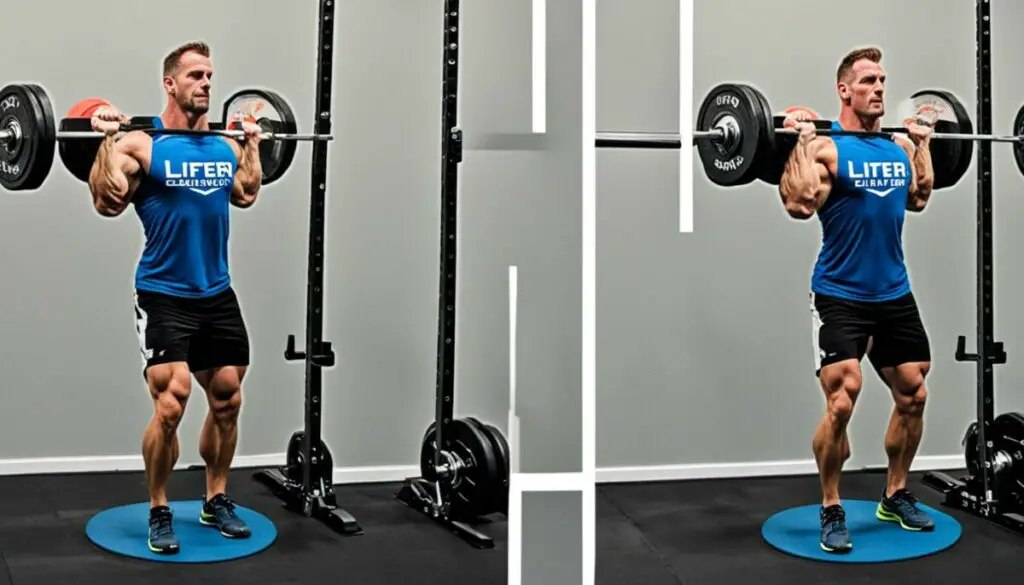Last Updated on 3 months by Francis
Looking to take your strength training to the next level? Snatch grip rack pulls might be just the exercise you need. This compound movement targets key muscle groups while offering variations that can be tailored to your goals and abilities.
Contents
Key Takeaways:
- Snatch grip rack pulls are a compound strength exercise that targets the erector spinae and lats muscles.
- They engage secondary muscles such as the hamstrings, glutes, upper traps, and forearms.
- Rack pull variations allow for variety in your training routine.
- Benefits of snatch grip rack pulls include back and trap hypertrophy, improved deadlift lockout strength, and reduced stress on the body compared to full deadlifts.
- Intermediate lifters with a solid foundation can benefit from incorporating snatch grip rack pulls into their training programs.
How to Perform Snatch Grip Rack Pulls

Snatch grip rack pulls are a powerful exercise that can help boost your strength and target specific muscle groups. To ensure proper execution, follow these steps:
- Set Up: Start by positioning the safety spotters just below your knees. This ensures that the barbell is in the correct starting position and provides a safety measure if the weight becomes too heavy. Add weight plates to the barbell, making sure they are evenly distributed on both sides. Secure the plates with weight clips to prevent any shifting during the exercise.
- Grip and Stance: Take a wide grip on the barbell, with your hands at hip crease width. This wider grip engages more muscles and places greater emphasis on the upper back. Position your feet between hip and shoulder width apart, finding a stance that feels stable and allows for proper alignment during the movement.
- Posture: Before lifting the barbell, focus on your posture. Keep your spine neutral, maintaining a natural curve in your lower back. Engage your lats, or the muscles on the sides of your back, and retract your shoulder blades. This position helps stabilize your torso and promotes optimal muscle engagement.
- Execution: With your body properly aligned, initiate the movement by pressing your feet into the ground. Squeeze your glutes and hamstrings to create tension and generate power. As you lift the barbell, keep it in contact with your legs throughout the entire range of motion. Extend your hips and stand upright, maintaining tension in your upper back and core.
- Lowering: To complete the exercise, lower the barbell back down in a controlled manner. Maintain tension in your muscles as you slowly reverse the movement, ensuring that the weight is under control at all times. Lower the bar until it reaches the safety spotters or the starting position, ready for the next rep.
Remember to perform each repetition with proper snatch grip rack pull technique and form. Focus on maintaining tension in your muscles and executing the movement smoothly. With practice and consistency, you can master snatch grip rack pulls and take your strength training to the next level.
Muscles Worked in Snatch Grip Rack Pulls

When performing snatch grip rack pulls, you engage several key muscles in your body. The primary muscles targeted during snatch grip rack pulls are the erector spinae and latissimus dorsi (lats). These muscles are crucial for spinal extension and stability. By challenging and strengthening these muscles, snatch grip rack pulls can contribute to a more robust and stable spine.
In addition to the erector spinae and lats, snatch grip rack pulls also involve various secondary muscles, including:
- Hamstrings: The hamstrings play a significant role in hip extension during the movement, assisting in pulling the barbell upwards.
- Glutes: The glute muscles are also activated to aid in hip extension and contribute to overall pulling power.
- Upper Traps: The upper trapezius muscles assist in scapular retraction, keeping the shoulders stable and aiding in maintaining proper form during the exercise.
- Forearms: While primarily a back and lower body exercise, snatch grip rack pulls also engage the forearms to some extent, helping to grip and hold onto the barbell.
By effectively targeting and working these muscles, snatch grip rack pulls provide a comprehensive full-body workout, promoting overall strength development and muscle growth.
Snatch Grip Rack Pulls vs Regular Deadlifts

When it comes to compound exercises that target similar muscle groups, snatch grip rack pulls and regular deadlifts are often compared. While these exercises share similarities, there are significant differences worth considering. Understanding the distinctions between snatch grip rack pulls and regular deadlifts can help you make informed decisions about which exercise to incorporate into your strength training program.
The Range of Motion
One of the primary differences between snatch grip rack pulls and regular deadlifts is the range of motion. Snatch grip rack pulls have a shorter range of motion compared to regular deadlifts. This shorter range allows you to handle heavier weights, promoting strength development and muscle overload. Regular deadlifts, on the other hand, require you to lift the weight from the floor, resulting in a longer range of motion.
Focus on Muscle Groups
Another distinction lies in the specific muscle groups targeted during these exercises. Snatch grip rack pulls emphasize the upper back and traps due to the wider grip used. By engaging the upper back and traps, snatch grip rack pulls can help you develop a more muscular upper body. Regular deadlifts primarily focus on the lower back and glutes, contributing to overall lower body strength and power.
Benefits and Training Program
Both snatch grip rack pulls and regular deadlifts offer unique benefits that can enhance your strength training program. Snatch grip rack pulls are beneficial for improving upper body strength, specializing in the upper back and traps. Regular deadlifts, with their emphasis on the lower body, can contribute to overall strength development and power generation. To achieve a well-rounded training program, consider incorporating both exercises at appropriate intensities and volumes.
Rack Pull Variations

Rack pulls offer a variety of variations that can spice up your training routine and keep your muscles guessing. These variations target different muscle groups and focus on specific aspects of the lift, allowing you to challenge yourself in new ways and continue making progress towards your fitness goals.
Below-the-Knee Rack Pull
The below-the-knee rack pull is a variation of the rack pull where the barbell is set just below your knees. This variation puts more emphasis on the lower back and glutes, helping to strengthen those muscles and improve your deadlift lockout. It also allows you to handle heavier weights, making it a great option for building strength and power.
Above-the-Knee Rack Pull
On the other hand, the above-the-knee rack pull focuses more on the upper back and traps. By setting the barbell slightly above your knees, you’ll engage these muscles more effectively and develop a stronger upper body. This variation is particularly beneficial for improving your posture and building a muscular upper back.
Snatch Grip Rack Pull
The snatch grip rack pull is a challenging variation that targets the posterior chain, including the back, hamstrings, and glutes. With a wider grip on the bar and a wider stance, you’ll activate more muscles and increase the range of motion. This variation is excellent for developing full-body strength and improving snatch grip deadlifts.
By incorporating these rack pull variations into your training, you’ll keep your workouts exciting and constantly push your limits. Each variation offers unique benefits and focuses on different muscle groups, ensuring a well-rounded and effective strength training program.
| Rack Pull Variation | Main Targeted Muscles | Focus of the Lift |
|---|---|---|
| Below-the-Knee Rack Pull | Lower back, glutes | Deadlift lockout, strength |
| Above-the-Knee Rack Pull | Upper back, traps | Posture, upper body strength |
| Snatch Grip Rack Pull | Back, hamstrings, glutes | Full-body strength, snatch grip deadlifts |
As you can see, each rack pull variation has its own unique benefits and focuses on different muscle groups. Incorporating these variations into your training will help you achieve a well-rounded physique and maximize your strength potential.
Rack Pull Benefits

Rack pulls offer several benefits for strength and muscle development. They place significant stress on the traps, leading to trap hypertrophy and a more muscular upper back. Rack pulls also target the back muscles, contributing to overall back thickness and width. Additionally, rack pulls can help with the lockout portion of the deadlift, as they focus on the upper portion of the lift. This can improve pulling strength and explosiveness. Furthermore, rack pulls place less stress on the body compared to full deadlifts, allowing for higher-volume training without excessive fatigue.
By incorporating rack pulls into your training routine, you can experience these key benefits:
- Increased trap size and upper back development
- Enhanced back thickness and width
- Improved deadlift lockout strength
- Enhanced pulling strength and explosiveness
- Ability to perform higher-volume training with less fatigue
Whether you are looking to build muscle, increase strength, or improve your deadlift performance, rack pulls can be an effective exercise to include in your training program.
Who Should Do Snatch Grip Rack Pulls

The snatch grip rack pull is a demanding exercise that requires a solid foundation of strength and technique. It is not recommended for beginners who are still mastering the basics of the hip hinge and pulling movements. Intermediate lifters who are looking to target their back, traps, and overall pulling strength can benefit from incorporating snatch grip rack pulls into their training program. To get the most out of this exercise, it is important to follow a proper snatch grip rack pull program tailored to your individual goals and abilities.
Benefits of Snatch Grip Rack Pull Program
By including the snatch grip rack pull in your training routine, you can experience a range of benefits. Some of the key advantages of following a snatch grip rack pull program include:
- Increased back and trap development
- Improved pulling strength
- Enhanced muscle hypertrophy in the target muscle groups
- Greater deadlift lockout strength and explosiveness
- Diversification of your training routine
To maximize these benefits, it is important to follow a snatch grip rack pull program that is tailored to your specific goals and abilities. This may involve adjusting the volume, intensity, and frequency of the exercise to meet your individual needs. Consulting with a qualified coach or trainer can help ensure that you are following an effective and safe snatch grip rack pull program.
Tips for a Successful Snatch Grip Rack Pull Program
When embarking on a snatch grip rack pull program, keep the following tips in mind to optimize your progress and minimize the risk of injury:
- Focus on technique: Proper form is essential for performing snatch grip rack pulls safely and effectively. Ensure that you maintain a neutral spine, engage your lats, and retract your shoulder blades throughout the movement.
- Gradually increase the weight: Start with a weight that allows you to maintain proper form and gradually increase the weight as you become stronger and more proficient in the exercise.
- Balance with other exercises: While snatch grip rack pulls can be a valuable addition to your training program, it is important to incorporate a variety of other exercises that target different muscle groups and movement patterns to maintain a balanced routine.
- Listen to your body: Pay close attention to how your body responds to the snatch grip rack pull program. If you experience any discomfort or pain, it is important to modify the program or seek guidance from a qualified professional.
Remember, consistency and dedication are key when it comes to achieving your fitness goals. Stay committed to your snatch grip rack pull program and monitor your progress over time to ensure that you are on track to reach your desired outcome.
Benefits of Including Rack Pulls in Your Training

Incorporating rack pulls into your training routine offers numerous benefits for strength and muscle development. Whether you are a seasoned lifter or just starting out, rack pulls can enhance your workouts and help you reach your fitness goals.
1. Build Strength and Muscle Mass
Rack pulls target the back, traps, and other muscle groups, making them an effective exercise for building overall strength and muscle mass. By incorporating this compound movement into your training, you can stimulate muscle growth and improve your overall physique.
2. Improve Deadlift Lockout Strength and Explosiveness
Rack pulls specifically target the lockout portion of the deadlift, which is the final and often most challenging part of the lift. By focusing on this range of motion, rack pulls can help improve your deadlift lockout strength and explosiveness. This translates to better performance in deadlifts and other pulling exercises.
3. Add Variety to Your Workouts
Rack pulls offer a unique variation to traditional deadlifts, adding variety to your training routine. By incorporating rack pulls, you can challenge your muscles in new ways and prevent plateaus in your progress. This variety can keep your workouts engaging and exciting, making it easier to stay motivated and committed to your fitness journey.
4. Efficient and Time-Effective
Rack pulls are efficient and time-effective exercises, allowing for high-volume training without excessive fatigue. They require fewer repetitions and sets compared to full deadlifts, yet still provide similar benefits. This efficiency can be especially beneficial for individuals with limited time for training or those looking to maximize their workout sessions.
5. Enhance Overall Strength Training
By incorporating rack pulls into your training program, you can enhance your overall strength training. They work multiple muscle groups simultaneously, promoting balanced muscle development and improving your performance in other exercises. Rack pulls can complement your existing training routine and help you achieve a well-rounded level of strength and fitness.
Tips for Performing Snatch Grip Rack Pulls
When performing snatch grip rack pulls, it is important to maintain proper technique and form. Here are some valuable tips to help you optimize your snatch grip rack pull technique and form:
-
Focus on keeping a neutral spine: Maintaining a neutral spine is crucial to prevent unnecessary strain on your back. Keep your core engaged and avoid rounding or arching your back throughout the movement.
-
Engage your lats and upper back: To maximize the activation of your back muscles, focus on squeezing and engaging your lats and upper back throughout the entire lift. This will help you maintain stability and generate power.
-
Avoid arching or leaning back at the top of the lift: It is common to see lifters arching or leaning back excessively at the top of the lift. Instead, focus on maintaining a tall posture without hyperextension. This will ensure that the exercise targets the intended muscle groups effectively.
-
Maintain tension and control the eccentric portion: Pay attention to the eccentric portion of the movement when you lower the weight back down. Control the descent and maintain tension in your muscles throughout. This controlled eccentric phase helps build strength and stability.
-
Use a grip width that is comfortable and allows for proper wrist alignment: Experiment with different grip widths to find the one that feels most comfortable for you. Your grip should allow for proper alignment of your wrists, reducing strain and potential injuries.
-
Inhale prior to initiating the lift and exhale at the top: Breathing properly during snatch grip rack pulls is essential for maintaining stability and generating power. Inhale deeply before lifting the weight and exhale forcefully at the top of the concentric portion to engage your core and stabilize your spine.
By following these tips, you can perform snatch grip rack pulls with proper technique and form, maximizing the benefits of this exercise for your strength and muscle development.
Common Mistakes to Avoid in Rack Pulls
When performing rack pulls, it’s crucial to be aware of common mistakes that can hinder your progress and increase the risk of injury. By understanding these mistakes and taking steps to avoid them, you can perform rack pulls with proper technique and maximize your results.
Arching at the Top of the Lift
One of the most common mistakes in rack pulls is arching the back excessively at the top of the lift. While it’s important to engage the muscles of the upper back and traps, over-arching can lead to an imbalance and compromise your form. Instead, focus on maintaining a neutral spine throughout the movement, keeping your core engaged, and avoiding excessive hyperextension.
Pulling with the Arms and Back Instead of Using Force through the Ground
Another common mistake is relying too heavily on the arms and back to initiate the lift, rather than generating force through the ground. Remember that rack pulls are a compound exercise that should involve the entire body, with the legs and hips driving the movement. To correct this mistake, focus on pushing your feet into the ground and engaging your leg muscles to initiate the lift, while keeping your upper back and arms engaged for stability.
Looking Down at the Weights
Looking down at the weights during rack pulls can lead to poor posture and strain on the neck and upper back. Instead, maintain a neutral gaze straight ahead or slightly upward, which helps to keep your spine aligned and your body in proper position. This will not only improve your form but also reduce the risk of injury.
Incorrect Grip Width and Neglecting Shoulder Blade Retraction
Using an incorrect grip width can impact your stability and limit the effectiveness of the exercise. Make sure to choose a grip width that feels comfortable and allows for proper wrist alignment. Additionally, it’s important to focus on retracting your shoulder blades and engaging the rhomboids throughout the movement. This helps to maintain a strong and stable upper back position, enhancing the benefits of the exercise.
Over-Arching the Back at the Top of the Lift
Similar to the previous mistake, over-arching the back at the top of the lift can compromise your form. While it’s natural to extend the hips and squeeze the glutes at the top of the movement, be mindful of not overextending or hyperextending the lower back. Maintain control and a neutral spine position as you complete the lift, ensuring proper alignment and minimizing the risk of strain or injury.
Lowering the Weight Too Quickly
Lowering the weight in a controlled manner is just as important as the concentric portion of the lift. Avoid the mistake of lowering the weight too quickly, as this can increase the risk of injury and hinder your progress. Instead, focus on maintaining control and tension throughout the eccentric portion of the movement, slowly lowering the weight back to the starting position.
By avoiding these common mistakes, you can perform rack pulls with optimal technique, reduce the risk of injury, and maximize the benefits of this compound exercise.
Incorporating Rack Pulls into Your Training Program
If you’re looking to enhance your strength and target your back and pulling muscles, incorporating rack pulls into your training program can be a game-changer. Rack pulls are a compound exercise that can be included on your back or deadlift day to add variety and intensity to your workouts. Here’s how you can effectively incorporate rack pulls into your training program:
Start with Proper Form and Gradually Increase Weight
Before adding rack pulls to your program, it’s crucial to start with the correct form. Position yourself in the power rack or on blocks with the barbell at knee height. Set your grip width and ensure your back is neutral. Begin with a weight that allows you to maintain proper form and gradually increase it as you get stronger. This progressive overload will help you build strength and muscle mass over time.
Determine the Sets and Reps Based on Your Goals
The number of sets and reps you perform during rack pulls will depend on your goals. If you’re aiming for strength and power, lower rep ranges (3-5 reps) with heavier weights are recommended. Alternatively, if hypertrophy and muscle growth are your focus, higher rep ranges (8-12 reps) with moderate weights can be beneficial. Experiment with different set and rep schemes to find what works best for your training objectives.
Add Rack Pulls Once a Week
Consider adding rack pulls to your program once a week to allow for adequate recovery and prevent overtraining. This frequency enables you to consistently work on your pulling strength and technique while maintaining energy levels for other exercises in your training routine. It’s important to listen to your body and adjust the frequency as needed based on your individual recovery capabilities.
Combine with Other Deadlift Variations and Accessory Exercises
Rack pulls can be complemented with other deadlift variations and accessory exercises to create a well-rounded training program. This combination allows you to target different muscle groups, address specific weaknesses, and promote overall strength and muscular development. Consider incorporating exercises such as Romanian deadlifts, bent-over rows, and pull-ups to further enhance your posterior chain and pulling power.
By following these guidelines and tailoring your program to your goals and abilities, you can effectively incorporate rack pulls into your training routine. Remember to prioritize proper form, gradually increase weight, and listen to your body to ensure optimal progress and prevent injuries.
| Exercise | Sets | Reps | Rest |
|---|---|---|---|
| Rack Pulls | 3 | 8 | 2 minutes |
| Romanian Deadlifts | 3 | 10 | 90 seconds |
| Bent-Over Rows | 3 | 8 | 2 minutes |
| Weighted Pull-Ups | 3 | 6 | 90 seconds |
Remember to adjust the volume and intensity of your program based on your individual training capacity and recovery abilities. With consistent effort and proper programming, rack pulls can be a valuable addition to your training regimen, helping you achieve your strength and muscle-building goals.
Conclusion
Snatch grip rack pulls are an excellent addition to any strength training program. By incorporating this compound exercise into your routine, you can target the back and pulling muscles, improve deadlift performance, and enhance overall strength. Snatch grip rack pulls offer a variety of variations that can be tailored to your specific goals and abilities, allowing for continued progress and growth.
When performing snatch grip rack pulls, it is crucial to prioritize proper technique and form. This includes maintaining a neutral spine, engaging the lats and upper back, and avoiding common mistakes such as over-arching the back or pulling with the arms. By focusing on these key elements, you can maximize the benefits of snatch grip rack pulls while reducing the risk of injury.
Whether you are an intermediate lifter or aiming to advance your deadlift capabilities, snatch grip rack pulls can help you reach your goals. By incorporating this exercise into your training program, along with other deadlift variations and accessory exercises, you can build strength, promote muscle growth, and improve your overall pulling strength. Remember, consistency and commitment are key, so stick to your snatch grip rack pull program and watch your progress soar!
FAQ
What are snatch grip rack pulls?
Snatch grip rack pulls, also known as wide grip rack pulls, are a compound strength exercise that primarily targets the erector spinae and lats muscles. This exercise involves performing a partial deadlift movement by starting with the barbell or weight plates elevated on a power rack or blocks.
How do you perform snatch grip rack pulls?
To perform snatch grip rack pulls, start by positioning the safety spotters just below your knees. Add weight plates and secure them with weight clips. Use a wide grip, with your hands at hip crease width. Position your feet between hip and shoulder width apart. Keep your spine neutral, engage your lats, and retract your shoulder blades. Initiate the movement by pressing your feet into the ground and squeezing your glutes and hamstrings. Keep the bar against your legs as you extend your hips and stand upright. Maintain tension throughout the movement and lower the weight back down in a controlled manner.
Which muscles does snatch grip rack pulls work?
Snatch grip rack pulls primarily target the erector spinae and lats muscles. These muscles are responsible for spinal extension and stability. The exercise also engages secondary muscles such as the hamstrings, glutes, upper traps, and forearms.
How do snatch grip rack pulls compare to regular deadlifts?
Snatch grip rack pulls and regular deadlifts are both compound exercises that target similar muscle groups. However, there are some key differences between the two. Snatch grip rack pulls have a shorter range of motion compared to regular deadlifts, which allows for heavier weights to be used. This makes snatch grip rack pulls beneficial for strength development and overloading the muscles. Additionally, the snatch grip in rack pulls places more emphasis on the upper back and traps, while regular deadlifts primarily focus on the lower back and glutes.
What are some variations of rack pulls?
Rack pulls offer variations that can add variety to your training routine. Some popular rack pull variations include the below-the-knee rack pull, above-the-knee rack pull, and snatch grip rack pull. Each variation targets different muscle groups and places emphasis on specific aspects of the lift.
What are the benefits of rack pulls?
Rack pulls offer several benefits for strength and muscle development. They place significant stress on the traps, leading to trap hypertrophy and a more muscular upper back. Rack pulls also target the back muscles, contributing to overall back thickness and width. Additionally, rack pulls can help with the lockout portion of the deadlift, as they focus on the upper portion of the lift. This can improve pulling strength and explosiveness. Furthermore, rack pulls place less stress on the body compared to full deadlifts, allowing for higher-volume training without excessive fatigue.
Who should do snatch grip rack pulls?
Snatch grip rack pulls are recommended for intermediate lifters who have a solid foundation of strength and technique. They are not ideal for beginners, as novices should first master the fundamentals of the hip hinge and pulling motions. Snatch grip rack pulls can be included in a comprehensive strength training program to target the back, traps, and overall pulling strength.
What are the benefits of including rack pulls in your training?
Including rack pulls in your training routine offers several benefits. They can help build strength and muscle mass in the back, traps, and other targeted muscle groups. Rack pulls also contribute to better deadlift lockout strength and explosiveness. By incorporating rack pulls, you can add variety to your workouts and challenge your muscles in new ways. These exercises are efficient and time-effective, allowing for high-volume training without excessive fatigue.
What are some tips for performing snatch grip rack pulls with proper technique?
When performing snatch grip rack pulls, it is important to maintain proper technique and form. Focus on keeping a neutral spine and engaging your lats and upper back throughout the movement. Avoid arching or leaning back at the top of the lift. Maintain tension and control the eccentric portion of the movement as you lower the weight back down. Make sure to use a grip width that is comfortable and allows for proper wrist alignment.
What are common mistakes to avoid in rack pulls?
Common mistakes to avoid in rack pulls include arching at the top of the lift, pulling with the arms and back instead of using force through the ground, and looking down at the weights, which can lead to poor posture. It is also important to use the correct grip width and focus on retracting the shoulder blades and engaging the rhomboids. Avoid over-arching the back at the top of the lift and lower the weight in a controlled manner.
How can rack pulls be incorporated into a training program?
To incorporate rack pulls into your training program, you can include them as a compound exercise in your back or deadlift day. Start with a weight that allows you to maintain proper form and gradually increase the weight as you get stronger. You can perform rack pulls for a specific number of sets and reps, depending on your goals. Consider adding rack pulls to your program once a week, in addition to other deadlift variations and accessory exercises that target the back and pulling muscles.








